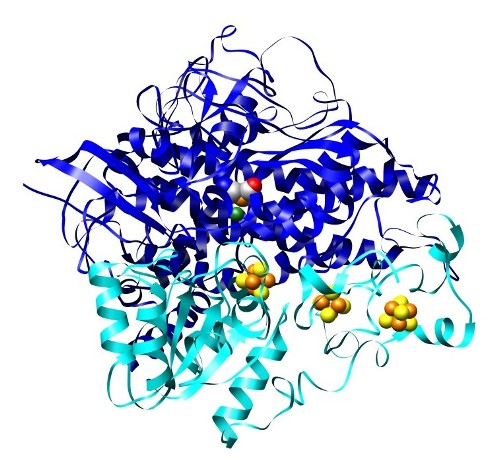D3/E3 - Activation of H/O systems:
dihydrogen, dioxygen, water and hydrogen peroxide
The research on the activation of H2, O2, and H2O, originally mainly centred in biocatalysis (E3), has received a steadily growing "chemical" counterpart (D3), initially restricted to the synthesis of biomimetic models but more recently extended to the synthesis of (bioinspired) functional catalysts.
On the basis of the achievements in the 1st funding period, the research on hydrogenase and photosystems in E3 will not only be directed to elucidate catalytic mechanism but also include further steps towards probing and controlling the catalytic processes in complex environments, ranging from hybrid systems up to whole cells. Special emphasis will be placed on the coupling of H2 and O2 activation.
D3 - Chemical activation of dihydrogen, dioxygen, water, and hydrogen peroxide
The research in the "chemical" projects of this research band, dedicated to the activation of hydrogen and water, is shifted from biomimetic cofactor models via bioinspired complexes up to functional catalysts. A trinuclear Ni compound displaying catalytic activity towards dihydrogen activation serves as a starting point for further syntheses including Ni hydride bonds as essential building blocks (D3-1) and will be extended to hetero-trinuclear [Ni2Fe] complexes.
Project D3-2 is geared towards the same target process but using "frustrated Lewis pairs" (FLPs) that may allow for heterolytic dihydrogen activation and hydrogenation catalysis at atmospheric pressure and ambient temperature without involving precious metals.
Chemical catalysts for small molecule reactions are accessible following a bioinspired strategy to synthesise molecular Fe-based and (hetero)-bimetallic Fe-, Ni-, and/or Mo-containing complexes as well as metal-free graphitic C3N4-based materials (D3-3).
Complementary to E3-4, bioinspired functional metal oxides, which are suitable for catalytic water oxidation (D3-4) will be synthesised. Molecular single-source precursors enable the low temperature synthesis of metastable metal oxides in different morphologies and environments which are inaccessible by 'classical' high-temperature solid state synthesis.
Project Team
Antonietti, Bittl, Dau, Driess, Fischer, Hildebrandt, Kaupp, Limberg, Oestreich, Ray, Schwalbe, Strasser, Thomas, Zouni.
Former team members: Blechert, Enthaler, Greco, Maultzsch, Weidinger.
Main investigators are given in bold.
E3 - Biological activation of dihydrogen, dioxygen, water, and hydrogen peroxide
The most widely developed research activities in this band (D3/E3) are based on oxygen-tolerant hydrogenases, covering systems with different levels of complexity in analogy to the studies on OCM (D1-1).
Hydrogenase research in E3-1 and E3-2 combines the analysis of the catalytic processes on a molecular level in the isolated enzyme via hybrid devices and whole cells up to the optimisation of the fermentation processes, eventually leading to the development of large-scale reactors for technological exploitation of the light-driven hydrogen formation.
In nature, PSI is coupled to PSII where water is oxidised to molecular oxygen. Against the background of the progress in elucidating the structure of the water-oxidising complex achieved in the 1st funding period, the analysis of the enzymatic process in the 2nd funding period focuses on the electronic structures of the Mn cluster during the catalytic cycle as well as on assembly strategies (E3-3).
The reversed process, i.e., the reductive activation of dioxygen, as well as the reduction of H2O2 is in the centre of research project E3-4. This project begins with natural oxygenases and peroxidases and it aims at designing artificial catalysts based on "minimum" cofactor-protein complexes.
Project Team
Bittl/Teutloff, Dau, Dobbek, Driess, Fischer, T. Friedrich, Hildebrandt/Zebger, Kaupp, King, Leimkühler, Lenz, Mroginski, Neubauer, Scheerer, Scheller, Strasser, Thomas, Wollenberger, Zouni.
Former team members: Ansorge-Schumacher, Czekelius, B. Friedrich, Greco, Haag, von Klitzing, Lensen, Weidinger.
Main investigators are given in bold.





